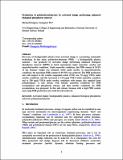Dynamics and function of intracellular carbohydrate in activated sludge performing enhanced biological phosphorus removal

View/
Date
2010Author
Wu, Guangxue
Rodgers, Michael
Metadata
Show full item recordUsage
This item's downloads: 938 (view details)
Cited 11 times in Scopus (view citations)
Recommended Citation
Wu, G., & Rodgers, M. (2010). Dynamics and function of intracellular carbohydrate in activated sludge performing enhanced biological phosphorus removal. Biochemical Engineering Journal, 49(2), 271-276.
Published Version
Abstract
Recovery of biodegradable plastics from activated sludge is a promising sustainable
technology. In this study, polyhydroxybutyrate (PHB) ¿ a biodegradable plastics
material - was produced by activated sludge performing enhanced biological
phosphorus removal (EBPR) in batch experiments under anaerobic, aerobic and
anaerobic/aerobic conditions. Under anaerobic conditions, the PHB content of 28.8%
of dry biomass weight was obtained, while under aerobic or anaerobic/aerobic
conditions, the maximum PHB content of 49-50% was achieved. The PHB production
rate with respect to the volatile suspended solids (VSS) was 70 mg/g VSS·h under
aerobic conditions, and this increased to 156 mg/g VSS·h under anaerobic condition
and to 200 mg/g VSS·h under aerobic conditions with energy also supplied from
polyphosphate. A side stream, with initially anaerobic conditions for PHB
accumulation and phosphorus release, and then aerobic conditions for PHB
accumulation, was proposed. In this side stream, biomass with a high PHB content
and a high PHB production rate could be both achieved.

